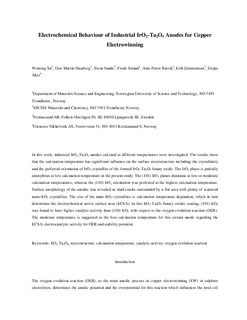| dc.contributor.author | Xu, Wenting | |
| dc.contributor.author | Haarberg, Geir Martin | |
| dc.contributor.author | Sunde, Svein | |
| dc.contributor.author | Seland, Frode | |
| dc.contributor.author | Ratvik, Arne Petter | |
| dc.contributor.author | Zimmerman, Erik | |
| dc.contributor.author | Åkre, Torjus | |
| dc.date.accessioned | 2017-11-01T07:56:00Z | |
| dc.date.available | 2017-11-01T07:56:00Z | |
| dc.date.created | 2017-03-02T06:53:47Z | |
| dc.date.issued | 2017 | |
| dc.identifier.citation | ECS Transactions. 2017, 75 (37), 23-35. | nb_NO |
| dc.identifier.issn | 1938-5862 | |
| dc.identifier.uri | http://hdl.handle.net/11250/2463321 | |
| dc.description.abstract | In this work, industrial IrO2-Ta2O5 anodes calcined at different temperatures were investigated. The results show that the calcination temperature has significant influence on the surface microstructure including the crystallinity and the preferred orientation of IrO2 crystallite of the formed IrO2-Ta2O5 binary oxide. The IrO2 phase is partially amorphous at low calcination temperature in the present study. The (101) IrO2 planes dominates at low or moderate calcination temperatures, whereas the (110) IrO2 orientation was preferred at the highest calcination temperature. Surface morphology of the anodes was revealed as mud-cracks surrounded by a flat area with plenty of scattered nano-IrO2 crystallites. The size of the nano-IrO2 crystallites is calcination temperature dependent, which in turn determines the electrochemical active surface area (ECSA). In this IrO2-Ta2O5 binary oxides coating, (101) IrO2 was found to have higher catalytic activity than (110) IrO2 with respect to the oxygen evolution reaction (OER). The moderate temperature is suggested as the best calcination temperature for this certain anode regarding the ECSA, electrocatalytic activity for OER and stability potential. | nb_NO |
| dc.language.iso | eng | nb_NO |
| dc.publisher | Electrochemical Society | nb_NO |
| dc.title | Electrochemical Behaviour of Industrial IrO2-Ta2O5 Anodes for Copper Electrowinning | nb_NO |
| dc.type | Journal article | nb_NO |
| dc.type | Peer reviewed | nb_NO |
| dc.description.version | acceptedVersion | nb_NO |
| dc.source.pagenumber | 23-35 | nb_NO |
| dc.source.volume | 75 | nb_NO |
| dc.source.journal | ECS Transactions | nb_NO |
| dc.source.issue | 37 | nb_NO |
| dc.identifier.doi | 10.1149/07537.0023ecst | |
| dc.identifier.cristin | 1455177 | |
| dc.relation.project | Norges forskningsråd: 228296 | nb_NO |
| dc.description.localcode | © The Electrochemical Society. This is the authors' accepted and refereed manuscript to the article. | nb_NO |
| cristin.unitcode | 194,66,35,0 | |
| cristin.unitname | Institutt for materialteknologi | |
| cristin.ispublished | true | |
| cristin.fulltext | postprint | |
| cristin.fulltext | preprint | |
| cristin.qualitycode | 1 | |
